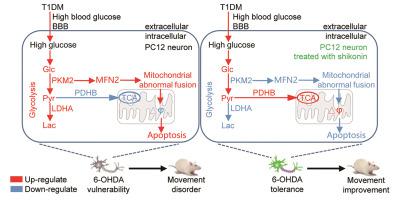Journal of Pharmaceutical Analysis ( IF 6.1 ) Pub Date : 2022-11-21 , DOI: 10.1016/j.jpha.2022.11.006 Ya Zhao 1 , Yanwei Wang 1 , Yuying Wu 1 , Cimin Tao 1 , Rui Xu 1 , Yong Chen 1 , Linghui Qian 1 , Tengfei Xu 1 , Xiaoyuan Lian 1

|
Epidemiological and animal studies indicate that pre-existing diabetes increases the risk of Parkinson's disease (PD). However, the mechanisms underlying this association remain unclear. In the present study, we found that high glucose (HG) levels in the cerebrospinal fluid (CSF) of diabetic rats might enhance the effect of a subthreshold dose of the neurotoxin 6-hydroxydopamine (6-OHDA) on the development of motor disorders, and the damage to the nigrostriatal dopaminergic neuronal pathway. In vitro, HG promoted the 6-OHDA-induced apoptosis in PC12 cells differentiated to neurons with nerve growth factor (NGF) (NGF-PC12). Metabolomics showed that HG promoted hyperglycolysis in neurons and impaired tricarboxylic acid cycle (TCA cycle) activity, which was closely related to abnormal mitochondrial fusion, thus resulting in mitochondrial loss. Interestingly, HG-induced upregulation of pyruvate kinase M2 (PKM2) combined with 6-OHDA exposure not only mediated glycolysis but also promoted abnormal mitochondrial fusion by upregulating the expression of MFN2 in NGF-PC12 cells. In addition, we found that PKM2 knockdown rescued the abnormal mitochondrial fusion and cell apoptosis induced by HG+6-OHDA. Furthermore, we found that shikonin (SK), an inhibitor of PKM2, restored the mitochondrial number, promoted TCA cycle activity, reversed hyperglycolysis, enhanced the tolerance of cultured neurons to 6-OHDA, and reduced the risk of PD in diabetic rats. Overall, our results indicate that diabetes promotes hyperglycolysis and abnormal mitochondrial fusion in neurons through the upregulation of PKM2, leading to an increase in the vulnerability of dopaminergic neurons to 6-OHDA. Thus, the inhibition of PKM2 and restoration of mitochondrial metabolic homeostasis/pathways may prevent the occurrence and development of diabetic PD.
中文翻译:

PKM2 介导的神经元糖酵解增加糖尿病大鼠患帕金森病的风险
流行病学和动物研究表明,预先存在的糖尿病会增加患帕金森病 (PD) 的风险。然而,这种关联的潜在机制仍不清楚。在本研究中,我们发现糖尿病大鼠脑脊液 (CSF) 中的高葡萄糖 (HG) 水平可能会增强亚阈值剂量的神经毒素 6-羟基多巴胺 (6-OHDA) 对运动障碍发展的影响,以及对黑质纹状体多巴胺能神经通路的损害。在体外,HG 促进 6-OHDA 诱导的 PC12 细胞凋亡,分化为具有神经生长因子 (NGF) 的神经元 (NGF-PC12)。代谢组学表明,HG促进神经元糖酵解过度,损害三羧酸循环(TCA循环)活性,这与线粒体融合异常密切相关,从而导致线粒体丢失。有趣的是,HG 诱导的丙酮酸激酶 M2 (PKM2) 上调结合 6-OHDA 暴露不仅介导糖酵解,而且通过上调 MFN2 在 NGF-PC12 细胞中的表达促进异常线粒体融合。此外,我们发现 PKM2 敲低挽救了 HG+6-OHDA 诱导的异常线粒体融合和细胞凋亡。此外,我们发现 PKM2 抑制剂紫草素 (SK) 可恢复线粒体数量,促进 TCA 循环活性,逆转过度糖酵解,增强培养的神经元对 6-OHDA 的耐受性,并降低糖尿病大鼠 PD 的风险。总体而言,我们的结果表明,糖尿病通过上调 PKM2 促进神经元中的过度糖酵解和异常线粒体融合,从而导致多巴胺能神经元对 6-OHDA 的脆弱性增加。因此,





















































 京公网安备 11010802027423号
京公网安备 11010802027423号